Create QR Code Barcodes in Crystal Reports
QR Code 2D Barcodes in Crystal Reports
- This tutorial shows how to add QR Code barcodes to your Crystal Reports.
- See the video or simply follow the steps below.
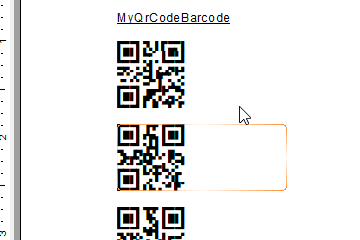
Step 1. Add a new formula
- In the Field Explorer, right click Formula Fields and click New...
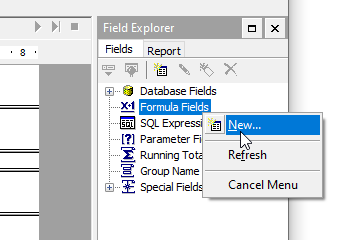
- Enter a name for the new formula

Step 2. Verify the QR Code functions
- Ensure the functions are installed. May be listed under one of these three locations:
Functions > Additional Functions
Functions > Additional Functions > Visual Basic UFLs (u2lcom.dll)
Functions > Additional Functions > COM and .NET UFLs (u212com.dll) - If missing, install the User Function Library
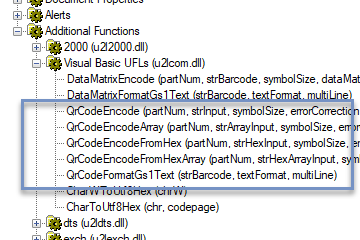
Step 3. Copy the formula text
- Copy the contents of this text into the Formula Editor:
// This is the text you wish to encode. Replace "Hello..." with your own data.
// For example: stringVar barcodeInput := {my_data_table.item_text};
//
// If your data is a number or date, it must be converted to string using the ToText() function.
// For example: local stringVar barcodeInput := ToText( {my_data_table.item_text}, 0, "");
local stringVar barcodeInput := "Hello World مرحبا بالعالم Witaj świecie";
// Minimum size of QR Code symbol.
// Valid sizes are 1-40, where size 1 equals 21x21 modules per side and size 40 equals 177x177.
// Note: Size of symbol will automatically increase if too small for the data.
local numberVar symbolSize := 1;
// Error correction level allows a partially damaged barcode to be scanned successfully.
// Valid values are 1-4, representing levels of L, M, Q, and H.
local numberVar errorCorrectionLevel := 1;
// Allows input of special characters in format ^000 where 000 is decimal ASCII code.
// For example, ABC^009123^013^010 encodes "ABC[TAB]123[CARRIAGE RETURN][LINE FEED]".
// To encode the actual caret ^, enter it twice: ^^
// To encode FNC1, enter: ^F1
local booleanVar allowSpecialChars := true;
// Determines what type of QR Code barcode to create.
// Set fnc1Mode to 0 to create "regular" QR Code barcodes (default)
// Set fnc1Mode to 1 to create GS1-QR barcodes.
// GS1-QR barcodes require input to be in the format: "(NN)XXXXXX(NN)XXXXXXXXX",
// where NN is a 2, 3, or 4-digit AI and XXXXXX is alphanumeric data to be encoded.
local numberVar fnc1Mode := 0;
// Thickness of quiet zone (space around barcode), in number of modules.
// Note: Minimum quiet zone in QR Code is 4 modules.
// If you add a border (borderWidth > 0), ensure quietZoneWidth is 4 or larger.
// Default value is 0 (no quiet zone)
local numberVar quietZoneWidth := 0;
// Thickness of border around barcode, in number of modules.
// If using a border, ensure quietZoneWidth is 4 or larger.
local numberVar borderWidth := 0;
// Character encoding of your data input.
// For example: UTF-8 | UTF-16 | ISO-8859-1 | ISO-8859-3 | ISO-2022-JP-2
// This setting should be set to UTF-16 (Unicode) for Crystal Reports 9 and newer
// Crystal Reports automatically converts all input (from database fields, strings, etc) into UTF-16.
local stringVar characterInputEncoding := "UTF-16";
// Character encoding for data encoded in the QR Code symbol.
// The recommended setting is UTF-8, which is the default for the majority of barcode scanners.
// If you change the setting, be sure the scanner understands it.
local stringVar characterOutputEncoding := "UTF-8";
local numberVar strLen := Length(barcodeInput);
local stringVar hex;
local stringVar xvals := "0123456789ABCDEF";
local numberVar i;
For i := 1 to strLen Do
(
local numberVar num := AscW(Mid(barcodeInput, i, 1));
local numberVar first := Remainder( num, 256);
local numberVar sec := Int( num / 256);
hex := hex + Mid(xvals, Int(first/16) + 1, 1) +
Mid(xvals, Remainder(first, 16) + 1, 1) +
Mid(xvals, Int(sec/16) + 1, 1) +
Mid(xvals, Remainder(sec, 16) + 1, 1);
);
local stringVar fullBarcode := "";
local numberVar partNumber := 0;
local stringVar result;
Do
(
result := QrCodeEncodeFromHex(partNumber, hex, symbolSize, errorCorrectionLevel,
allowSpecialChars, fnc1Mode, quietZoneWidth, borderWidth,
characterInputEncoding, characterOutputEncoding);
fullBarcode := fullBarcode + result;
partNumber := partNumber + 1;
)
While result <> "";
fullBarcode;Step 4. Edit the formula:
- Replace "Hello..." with your own data field.
// This is the text you wish to encode. Replace "Hello..." with your own data.
// For example: stringVar barcodeInput := {my_data_table.item_text};
//
// If your data is a number or date, it must be converted to string using the ToText() function.
// For example: local stringVar barcodeInput := ToText( {my_data_table.item_text}, 0, "");
local stringVar barcodeInput := {my_data_table.item_text};
- Click Save and Close.
Step 5. Add a barcode to the report
- Drag the formula from Field Explorer to the report.
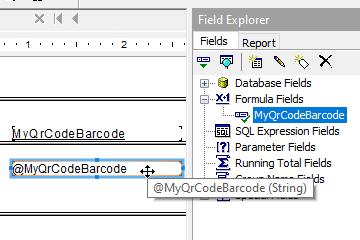
Step 6. Edit the text field
- Change the font to: BCW_QR and set the point size.
NOTE: For smaller barcodes, you can set the point size as low as 2pt
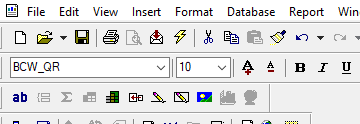
- Right-click and select Format Field...
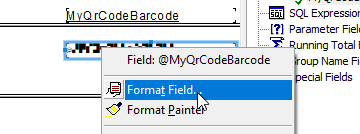
- Select Can Grow on the Common tab
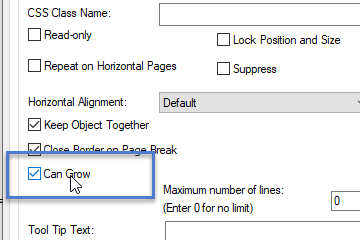
The report is now ready
- Click on Preview to see or print it.
